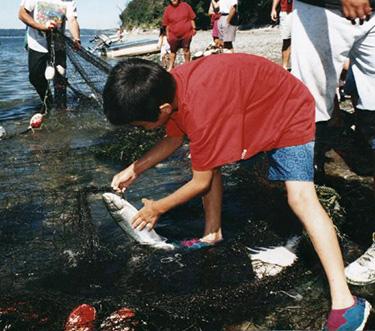
Photo Courtesy of Tulalip Tribes
from Earth Justice
Opposition to Kinder Morgan’s TransMountain proposed pipeline project ramped up today as Coast Salish peoples on both sides of the U.S.-Canadian border vowed to oppose the project as intervenors before Canada’s National Energy Board (NEB). Coast Salish intervenors include the Swinomish Indian Tribal Community, Tulalip Tribes, Lummi Nation, and Suquamish Tribe in Washington state, and the Musqueam, Squamish and Tsleil-Waututh Nations in British Columbia. The deadline for application to participate in the NEB process was [Wednesday] night at midnight.
“Over the last 100 years, our most sacred site, the Salish Sea, has been deeply impacted by our pollution-based economy,” said Swinomish Chairman Brian Cladoosby. “Every kind of pollution ends up in the Salish Sea. We have decided no more and we are stepping forward. It is up to this generation and future generations to restore and protect the precious waters of the Salish Sea.”
“Our people are bound together by our deep connection to Burrard Inlet and the Salish Sea. We are the ‘People of the Inlet’ and we are united in our resolve to protect our land, water and air from this risky project,” said Chief Maureen Thomas of the Tsleil-Waututh Nation. “We will use all lawful means to oppose it. This is why we have applied to intervene in the NEB hearing process.”
In December, Kinder Morgan filed an application with the NEB to build a new pipeline to bring tar sands oil from Alberta to Vancouver, B.C. The NEB is the Canadian federal agency that regulates interprovincial energy infrastructure. It is responsible for reviewing, recommending and regulating major energy projects, such as the Kinder Morgan Trans Mountain pipeline.
If approved, the proposal would see the transport of tar sands oil expanded from its present level of approximately 300,000 barrels per day to 890,000 barrels per day. With an almost seven-fold increase in oil tankers moving through the shared waters of the Salish Sea, an increase in groundings, accidents, incidents, leaks and oil spills is inevitable.
Experts have acknowledged that a serious oil spill would devastate an already-stressed marine environment and likely lead to collapses in the remaining salmon stocks and further contamination of shellfish beds, wiping out Indigenous fishing rights.
“The fishing grounds of the Salish Sea are the lifeblood of our peoples. We cannot sit idly by while these waters are threatened by reckless increases in oil tanker traffic and increased risk of catastrophic oil spill,” said Mel Sheldon, Chairman of the Tulalip Tribes.
The proposed tar sands pipeline expansion is one of several projects that would dramatically increase the passage of tankers, bulk carriers, and other vessels through Salish Sea shipping routes and adjacent waters on both sides of the U.S.-Canada border. In addition to oil, regulators in both countries are reviewing controversial proposals to export huge quantities of U.S. coal. Taken together, these projects would greatly increase the risk of oil spills and other accidents that threaten the Coast Salish economies and cultures.
“Today we are taking a stand to honor our ancient connection to the Salish Sea. The threat of oil spills and industrial pollution continue to threaten our way of life.” said Chief Ian Campbell of the Squamish Nation. “We stand in unity with all who care about the health of the Salish Sea and defend it for future generations.”
Chairman Timothy Ballew III of the Lummi Nation stated, “I am a fisherman, a father and a member of the great Lummi Nation. As the northernmost Washington Treaty Tribe of the Boldt Decision, we are the stewards the Salish Sea and will not allow the Kinder Morgan proposal along our waterways that will threaten our harvesting areas and further the detrimental impacts to the environment and natural resources.”

